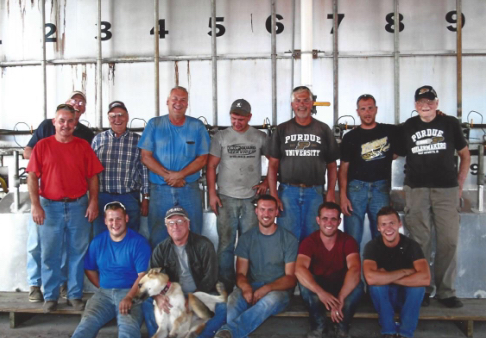 |
| Photo Credit: Kanne Farms |
 |
| Photo Credit: Kanne Farms |
Harvest has slowed down, but field work continues for mint farmers, weather cooperating. Mint can either be peppermint or spearmint. Peppermint is grown on the Kanne ground.
Mint plant spreads through the roots not seeds. The mint plant can last four years in a field. The first year it is considered row mint, years 2-4 are considered meadow fields because the plants spread out with runners. After the 4th year, the field is put back into a corn/soybean rotation.
Northern Indiana soils are good for mint production. Mint grows well in well-drained soils such as sandy soils, loamy soils, and muck grounds. Mint is grown for the oil in the leaves. Oil is stored in glands on the underside of the leaves.
 |
| Photo Credit: Kanne Farms |
 |
| Photo Credit: Kanne Farms |
When it is time to harvest the mint, mid July through August, it has to be mowed first. It will be placed into wind rows in the field to dry. When it is time to chop the mint, it is chopped into smaller pieces, and blown into the mint tub. The mint tubs are then transferred to the distillery by a tractor. The distillery is located on the Kanne Farm.
The tubs are hooked up to the distillery. The oil and vapors from the mint pass into the condensers with 15 pounds of pressure. Oil is drained into the barrels.
After the mint is cooked, the tubs are taken back to the fields and piled in plummies. During the fall, the mint fields are plowed 7 to 8 inches deep, the roots are dormant, and it helps with overwintering, disease and insect control. The plummie piles are then spread over the fields for protection over the winter months and leftover nutrients are added back to the field.
 |
| Photo Credit: Kanne Farms |
Mint usually is contracted three years out. The growers know how many acres they need to keep in rotation well in advance. The buying companies pick up the mint from the farm by 55-gallon barrels. It is very important to sample and grade all oil, especially since it is used in food-grade.
Peppermint oil is a very strong and distinct fragrance. The main end users are Colgate and Wrigley, farmers know their mint crop is going towards toothpaste, gum, and other flavored products.
This post was sponsored by The Glass Barn, brought to you by the Indiana Soybean Farmers. As always all thoughts and opinions are my own.









2 comments:
Nice idea,keep sharing your ideas with us.i hope this information's will be helpful for the new learners.
Software Testing Training in Chennai
Software testing training in OMR
JAVA Training in Chennai
Python Training in Chennai
Big data training in chennai
IOS Training in Chennai
Software Testing Training in Chennai
Software testing training in Tambaram
Great post! Choosing the right Cat Litter Box really makes a huge difference for both cats and owners. I especially like the focus on easy cleaning, safety, and accessibility—those are often overlooked but so important for daily use. Finding the Best Cat Litter Box for Easy Cleaning, Safety, and Accessibility can help reduce mess, keep odors under control, and make cats feel more comfortable. Thanks for sharing such helpful insights!
Post a Comment